Regional employment patterns in Scotland: statistics from the Annual Population Survey 2017
Summary publication of results from the Annual Population Survey 2017, presenting analysis on the labour market, education and training.
This document is part of a collection
Section 6: Inactivity
6.1 Inactivity over time
Who is classed as economically inactive?
Individuals aged 16-64 who are neither employed nor
unemployed under
ILO
definitions. There are many reasons why people may be inactive
and not considered an active part of the labour supply: they may
have a long-term illness or disability, be studying for a
qualification, staying at home to look after their family, or
have retired.
Scotland’s inactivity rate in 2017 was above the rate for the UK
The inactivity rate for those aged 16-64 in Scotland in 2017 was 22.5 per cent, higher than the UK rate of 21.8 per cent.
Over the year, the rate has decreased in both Scotland and the UK (down 0.7 and 0.5 percentage points respectively).
Scotland’s inactivity rate has increased slightly since 2007 (0.1 percentage points) while it decreased by 1.8 percentage points in the UK.
Chart 35: Economic Inactivity Rate (16-64), Scotland and UK
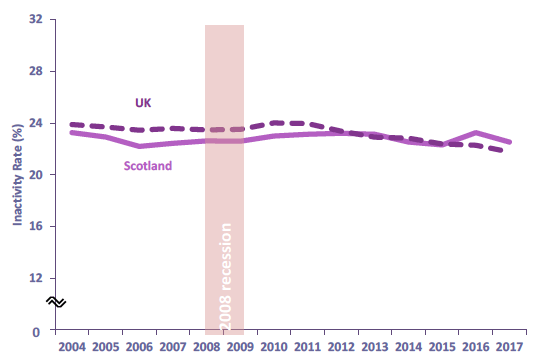
6.2 Local authorities
Economic Inactivity rates were highest in Dundee City, Glasgow City and North Ayrshire
There is considerable variation in inactivity rates for those aged 16-64 across Scotland’s local authorities.
In 2017, the highest economic inactivity rates were seen in Dundee City (32.3 per cent), Glasgow City (30.0 per cent) and North Ayrshire (26.2 per cent). The lowest rates were seen in Aberdeenshire (14.7 per cent), Highland (15.4 per cent) and Na h-Eileanan Siar (16.4 per cent).
Since 2016, economic inactivity rates decreased in 17 of the 32 local authority areas while 12 saw an increase in their inactivity rates and one remained unchanged (there is no data for Orkney and Shetland Islands). A statistically significant decrease between 2016 and 2017 was seen in East Ayrshire (down 4.9 percentage points from 28.2 per cent to 23.3 per cent).
Since 2007, economic inactivity rates increased in 16 of the 32 local authority areas while 14 saw a decrease in their inactivity rates. A statistically significant increase between 2007 and 2017 was seen in Dundee City (up 3.7 percentage points from 24.9 per cent to 32.3 per cent).
Figure 8: Inactivity Rate 2017 16-64 year olds (per cent)
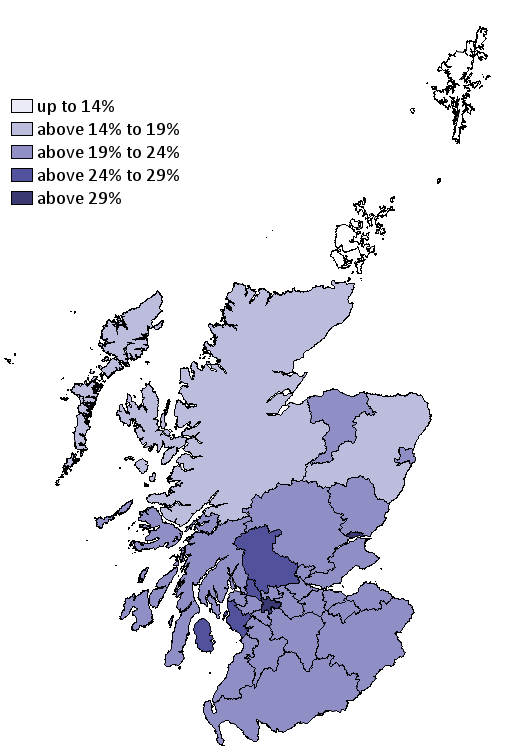
Note: Data for Orkney Islands and Shetland Islands are unavailable.
6.3 Gender
Decrease in the economic inactivity rate for Scotland over the year was mainly driven by decreased rates for women
The inactivity (16-64) rate for women in Scotland decreased by 1.0 percentage point from 27.5 per cent in 2016 to 26.5 per cent in 2017, driving the decrease in the overall economic inactivity rate over the same period (down 0.7 percentage points from 23.3 per cent to 22.5 per cent).
In Scotland, the inactivity rate for men decreased by 0.5 percentage points from 18.8 per cent to 18.4 per cent over the year.
Chart 36: Economic Inactivity Rate (16-64) by Gender, Scotland
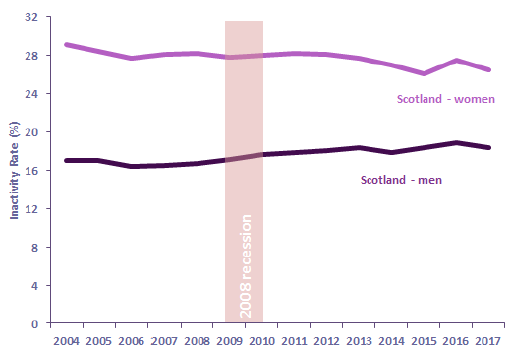
Chart 37: Economic Inactivity Rate (16-64) by Gender
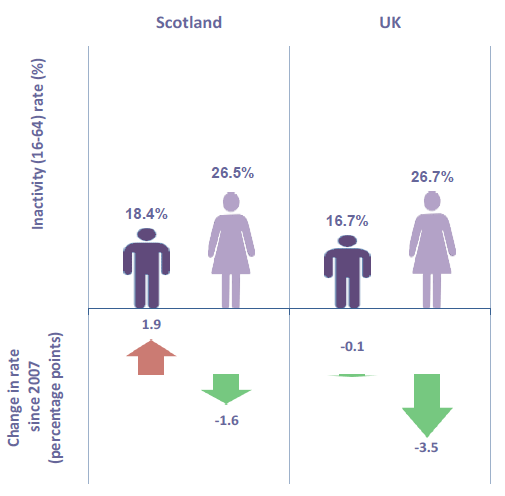
The slight increase in the overall economic inactivity rate for Scotland since 2007 was driven by men (up 1.9 percentage points to 18.4 per cent) while the decrease in the overall economic inactivity rate across the UK was driven by women (down 3.5 percentage points to 26.7 per cent).
6.4 Age
Increase in economic inactivity rates for those aged 16-24 and 35-49 since 2007
Economic inactivity rates for 25-34 year olds have remained around 15 per cent from 2004 to 2017 while the economic inactivity rates for 35-49 year olds remained fairly constant until 2014 when it started to increase, highlighting that more 35-49 year olds have become inactive in recent years.
Those aged 16-24 have seen their inactivity rates increase from 28.6 per cent in 2007 to 34.5 per cent in 2017. In contrast, inactivity rates for those aged 50-64 have generally been decreasing over time (34.1 per cent in 2007 to 28.1 per cent in 2017), highlighting that more people aged 50-64 are moving from being economically inactive to being in employment.
Since 2007, men are driving the increase in the inactivity rates for those aged 16-24 (men up 8.0 percentage points from 25.2 per cent to 33.2 per cent while women increased by 3.8 percentage points from 32.1 per cent to 35.9 per cent) and for those aged 35-49 (men up 2.0 percentage points from 8.6 per cent to 10.6 per cent while women increased by 0.4 percentage points from 18.8 per cent to 19.2 per cent). Women are driving the decrease in the inactivity rates for those aged 50-64 (women down from 41.8 per cent in 2007 to 32.1 per cent in 2017, while men down from 25.9 per cent to 23.9 per cent).
Chart 38: Economic Inactivity Rate (16-64) by age, Scotland
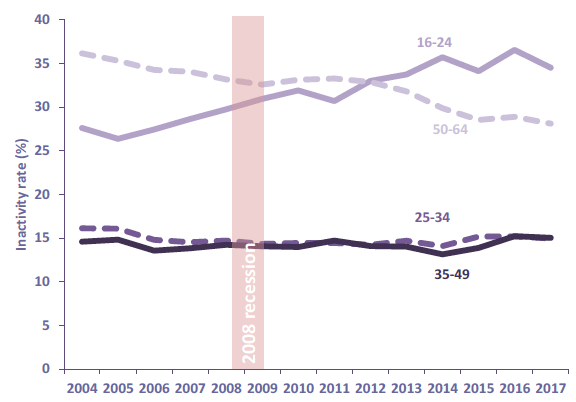
More recently, economic inactivity rates have decreased for all age groups since 2016 with men driving the decrease for those aged 16-49 and women driving the decrease for those aged 50-64.
6.5 Reasons for Inactivity
Over 50 per cent of the 768,900 economically inactive people in Scotland were inactive because they were long-term sick or students.
Of the 768,900 economically inactive people (aged 16-64) in 2017, the main reasons for being inactive were long-term sick or disabled (211,300, 27.5 per cent) and student (202,600, 26.3 per cent).
Chart 39: Reasons for Inactivity, Scotland, 2017
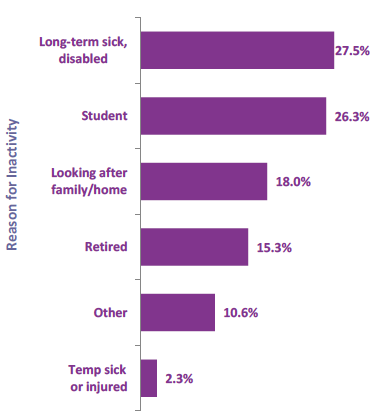
* other includes discouraged worker
Reasons for inactivity differ by gender with looking after family/home accounting for 5.7 per cent of inactive men and 26.1 per cent of inactive women. Long-term sick and temporary sick accounted for 36.7 per cent of inactive men and 25.2 per cent of inactive women.
Chart 40: Composition of those aged 16-64 who were economically inactive, Scotland
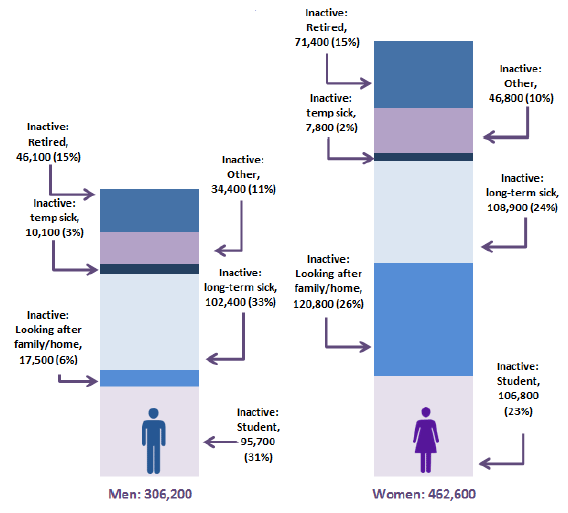
Increase in economic inactivity levels since 2007 was driven by increases in the number of students.
Economic inactivity levels in Scotland have increased by 15,100 since 2007. This has been driven mainly by a 57,600 increase in the number of students who were inactive as well as those who gave ‘Other’ as the reason for being inactive (up 16,800).
More recently, increases over the year were seen in the number of students and retired people who were inactive (up 9,300 and 4,800 respectively) while decreases were seen in the numbers looking after family/home, long-term sick or disabled and temporary sick who were inactive (down 24,700; 8,000 and 4,200 respectively).
Chart 41: Change in reasons for Inactivity since 2007, Scotland
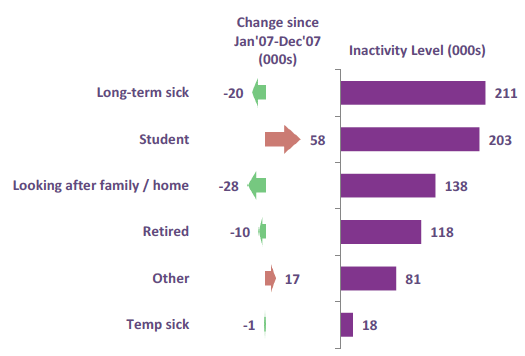
6.6 Want to work
23.7 per cent (182,400) of economically inactive people aged 16-64 in Scotland would like to work but were currently unable to do so.
The proportion of those who were economically inactive but who wanted to work has decreased since 2013, having previously been on an upward trend since 2010.
Since 2007, the proportion of those who were economically inactive who would like a job decreased by 0.9 percentage points from 24.6 per cent in 2007 to 23.7 per cent in 2017.
The proportion of economically inactive men aged 16-64 who would like a job decreased by 2.5 percentage points from 28.4 per cent in 2007 to 25.8 per cent in 2017, driving the decrease in the overall proportion of economically inactive people who would like a job over the same period. The proportion of economically inactive women aged 16-64 who would like a job decreased from 22.5 per cent in 2007 to 22.3 per cent in 2017 (0.2 percentage point decrease). However, the proportion of economically inactive women who would like a job has increased over the last year (up from 21.6 per cent in 2016 to 22.3 per cent in 2017).
Regional Differences
In 2017, the local authorities with the highest proportion of economically inactive people who would like to work were Clackmannanshire (33.5 per cent), Highland (33.1 per cent) and Aberdeen City (31.8 per cent). The lowest proportions were seen in Perth and Kinross (13.1 per cent), South Lanarkshire (14.9 per cent) and North Lanarkshire (16.7 per cent).
Chart 42: Proportion of economically inactive people (16-64) who would like a job by gender, Scotland
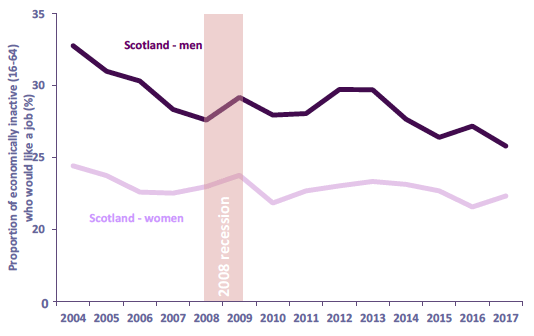
6.7 Never worked
152,000 people in Scotland in 2017 had never worked (excluding students aged 16-24 in full-time education).
In 2017, 299,700 people in Scotland aged 16 and over had never worked, an increase of 19,600 over the year. 49.3 per cent of the people in Scotland who had never worked were 16-24 year olds in full-time education.
Excluding 16-24 year olds in full-time education, there were 152,000 people in Scotland who had never worked; an increase of 1,300 over the year.
Since 2007, the number of people who have never worked including and excluding students aged 16-24 in full-time education has increased by 57,900 and 21,100, respectively.
Regional Differences
Since 2007, reductions in the number of people who have never worked were seen across 6 local authority areas with 22 seeing increases and one remaining unchanged. No information is available for Na h-Eileanan Siar, Orkney Islands or Shetland Islands.
The largest increases in the number of people who have never worked since 2007 were seen in Edinburgh City (up 16,100), South Lanarkshire (up 7,600) and Aberdeen City (up 7,100).
Chart 43: Number of people who have never worked (16+), Scotland
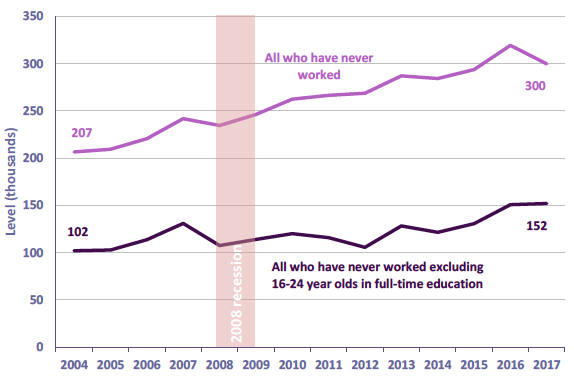
Note: The number of people who have never worked covers those aged 16+ who are currently unemployed or economically inactive.
Concepts and Definitions
Economic activity rate: The number of people who are in employment or unemployed expressed as a percentage of the relevant population.
Economic inactivity rate: The number of economically inactive people expressed as a percentage of the relevant population.
Economically active: The economically active population are those who are either in employment or unemployed.
Economically inactive: Economically inactive people are not in employment, but do not satisfy all the criteria for unemployment. This group is comprised of those who want a job but who have not been seeking work in the last 4 weeks, those who want a job and are seeking work but not available to start and those who do not want a job. For example, students not working or seeking work and those in retirement are classed as economically inactive. It can be useful for some purposes to consider only those who are both economically inactive and not of state pension age.
Employees: The division between employees and self-employed is based on survey respondents' own assessment of their employment status.
Employment: There are two main ways of looking at employment: the number of people with jobs or the number of jobs. These two concepts represent different things as one person can have more than one job. People aged 16 or over are classed as in employment (as an employee or self-employed) by the LFS, if they have done at least one hour of paid work in the week prior to their LFS interview or if they have a job that they are temporarily away from. People who do unpaid work in a family business and people on Government-supported training and employment programs are also included according to the International Labour Organisation ( ILO) convention.
Employment rate: The number of people in employment expressed as a percentage of the relevant population.
Model Based Unemployment: In 2003, ONS developed a statistical model to improve small area estimates of unemployment by using supplementary information from the claimant count - a count of the number of people claiming Jobseeker's Allowance. As it is an administrative measure, accurate information is known for all areas. It is also highly correlated with unemployment. The model is said to borrow strength from the claimant count. The model also includes a socio-economic indicator and a random area effect.
More information about the modelling methodology can be found here.
Rates: Rates represent the proportion of the population or subgroup of the population with a certain characteristic. They allow changes in the labour market to be interpreted in a wider context, allowing for changes in the overall population or the number of people who are economically active. Rates can be calculated for different age groups. For employment, economic activity and economic inactivity, the most widely quoted rates are those for the working age population. For unemployment, headline rates are expressed as a percentage of the economically active population aged 16 and over. Those over retirement age who continue to be economically active will therefore be included in the base while those who are economically inactive will not.
Self-employment: The division between employees and self-employed is based on survey respondents' own assessment of their employment status.
Unemployment: The ILO definition of unemployment covers people who are: not in employment, want a job, have actively sought work in the previous 4 weeks and are available to start work within the next fortnight, or, out of work and have accepted a job which they are waiting to start in the next fortnight.
Unemployment rate: The number of unemployed people expressed as a percentage of the relevant economically active population.
Working age: Note that due to changes in the state pension age, (specifically the current female state pension age which is changing dynamically to match the male state pension age) ONS no longer publish rates using a Working age definition in its statistical bulletins, but instead report rates for all people aged 16 to 64.
16 to 19 year olds Not in Employment, Education or Training ( NEET): The proportion of 16-19 year olds who are not classed as a student, not in employment nor participating in a government training programme. Note that the methodology for calculating the levels and proportions of those who are NEET have been modified this year to align with ONS’s methodology. The change is intended to account for a small number of non-respondents or persons whose economic or educational status were unknown. This group are now apportioned pro-rata across the main economic status categories whereas previously they had been excluded from the analysis. This should give more accurate estimates of the level of NEETs.
Disability: From 2014 the definitions of disability is based on the 2010 Equality Act Definition. This harmonized definitions is based on self-reported health conditions which has lasted 12 months or more which limits ability to carry out day-to day activities a little or a lot.
Minority ethnic: ‘White’ includes ‘White-Polish’ and ‘White Gypsy’.
Further information on Classifications and Standards is also available from the ONS website at https://www.ons.gov.uk/methodology/classificationsandstandards
Contact
If you have any enquiries relating to Labour Market Statistics then please contact us at:
Email: LMStats@gov.scot
Telephone: 0131 244 6773
Fax: 0300 244 1060
Post:
Labour Market Statistics
OCEAES: Economic Strategy and Policy
Scottish Government
5th Floor
5 Atlantic Quay
150 Broomielaw
Glasgow
G2 8LU
We welcome any comments on both the format and content of the website, including any problems you may encounter.
You may also contact the Statistician Group Enquiries for general information.
There is a problem
Thanks for your feedback